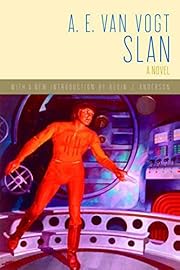Promotional note: I think I’ve finally got my social sharing buttons working, after switching to a different plugin (Kiwi Social Share). Please take advantage of them to let your book-loving friends know about these posts. Or copy and paste the URL of this article, which seems simpler to me.
Once again, my topic is eugenics in science fiction. It was popular and respectable in the early twentieth century. Numerous writers presented supermen, including Superman himself. A. E. Van Vogt’s Slan published in 1940, was a very popular instance. My copy has a 25 cent price on the cover and is about as old as I am.
Slans are people who live among us and look like us, as long as they can hide the tendrils under their hair. They’re vastly smarter than normal humans and have psychic powers. When they’re discovered, they face persecution. Many science fiction fans identified with them. There was a saying, “Fans are slans.”
The protagonist, Jommy Cross, starts out as a boy, isolated from slans outside his own family. He quickly finds himself fleeing for his life and losing his family. Eventually we learn that there is another kind of slan without tendrils. They hold great power in society, and they’re as hostile to the “true” slans as normal people are. At first he’s presented sympathetically, facing both normal humans and tendrilless slans as deadly enemies but wanting peace with them.
Various characters present different explanations for the origins of the two kinds of slans. At the end, an infodump presents what is presumably the real version of the story. What’s important is that slans are destined to replace normal humans. “Man will go into history along with the Java ape man, the Neanderthal beast man, and the Cro-Magnon primitive.” True and tendrilless slans will eventually converge.
Jommy discovers a mind control technique which he can use on large numbers of humans. The leader says his hypnotism crystals could be “the final solution to the problem of human antagonism.” It will be the reign of the supermen.
Slan isn’t the only story from the golden age of science fiction to present a superhuman race. Heinlein’s “Gulf” comes first to my mind. But it’s the only one I know of that presents them in a war to the death with normal humans. More often the supers are benevolent, though cautious about revealing themselves.
Livia Gershon’s article, “The Self-Styled Sci-Fi Supermen of the 1940s“, gives some perspective on the novel’s position in fan culture. She writes that there was a “superman boom” in science fiction starting about 1939. The “fans are slans” idea had some serious support. Two fans, Al and Abby Lu Ashley, proposed the creation of a “Slan Center” a city block in size, where fans could live and publish. They created a more modest “Slan Shack” in Michigan. Others made similar efforts in other areas.
Gershon sees a hint of a “quasi-fascist master race” in these efforts, though that may be stretching the point. First, it wasn’t the Fascist Party that promoted the idea of a master race. Second, I don’t think any of the slan fans saw their shacks as centers for building a totalitarian state.
The movement apparently started with a fan named Claude Degler. It’s hard to tell what’s reliable in newsletters and zines, but he seems to have taken the “fans are slans” idea seriously, regarding SF fans as the next stage in human evolution. He advocated something called “fanationalism,” which does sound a bit fascistic. What’s hard is to figure out, many decades later, is how much of this was tongue-in-cheek.
The self-identification of these groups with the slans is at least disturbing. The novel presents authoritarian attitudes as positive and shows a secret conspiracy of supermen controlling the world. Here’s a sample:
“Years ago, many human beings knew a lot about many of the secret passageways of the palace. One of my first acts, as soon as I was able, was to classify this knowledge. Then, one by one, I transferred to other parts of the world the men who had the information. There, isolated in various obscure government departments, they were skillfully assassinated.”
Science fiction has its dark side, and Slan is part of it.
Update: I should have remembered to check Harry Warner, Jr.’s All Our Yesterdays before posting this. His history of fandom adds a few interesting bits. He writes: “The virtue most frequently ascribed to supermen in fiction, telepathy, was also sought in fans with varying results. If Al Lopez wrote truthfully in an issue of Necromancer, he was the most skilled telepath in fandom.”
There were also skeptics. Warner quotes Francis T. Laney: “If we fans had the necessary ability to be New Order leaders, we would be demonstrating that superiority in actual research and inventions, rather than spending our time reading escape fiction, publishing fanzines, and writing whacky letters.”
On the whole, as Warner describes it, the fan-slan identification was more a matter of fans liking to stick with other fans, sometimes to a fanatical (which is where the word “fan” comes from) degree. There were no world domination plots that I’ve been able to uncover.